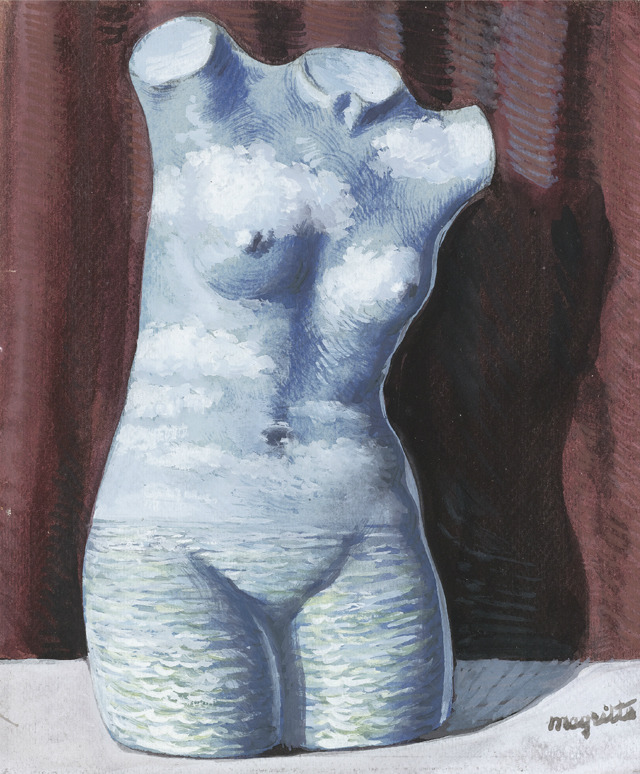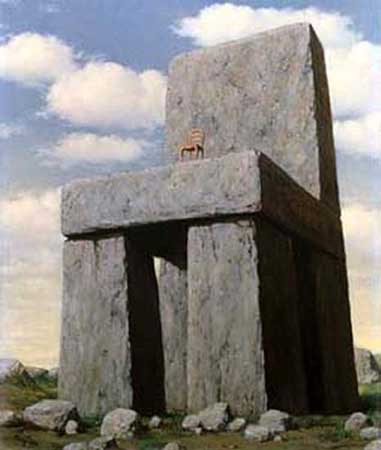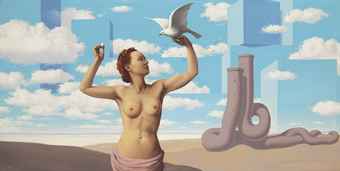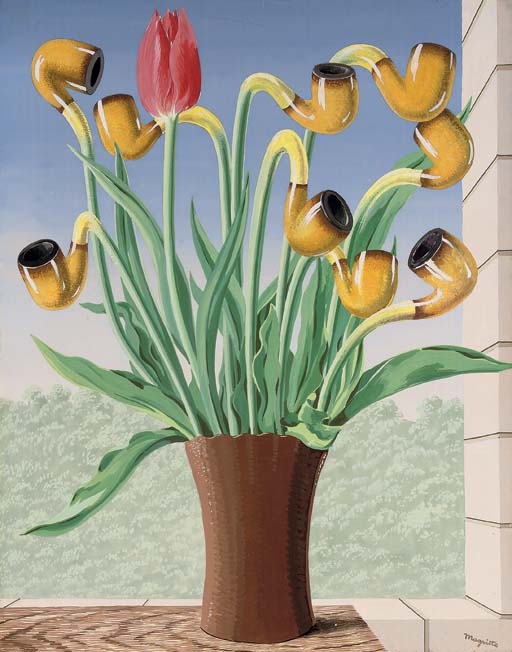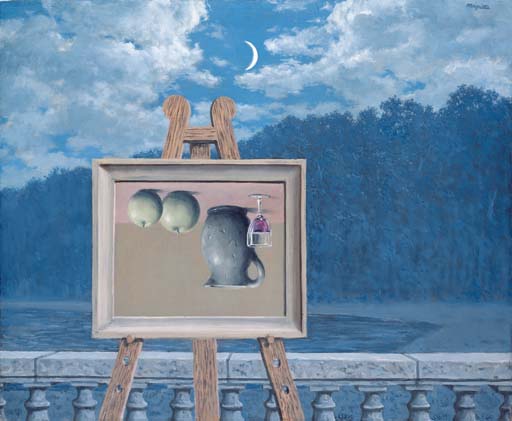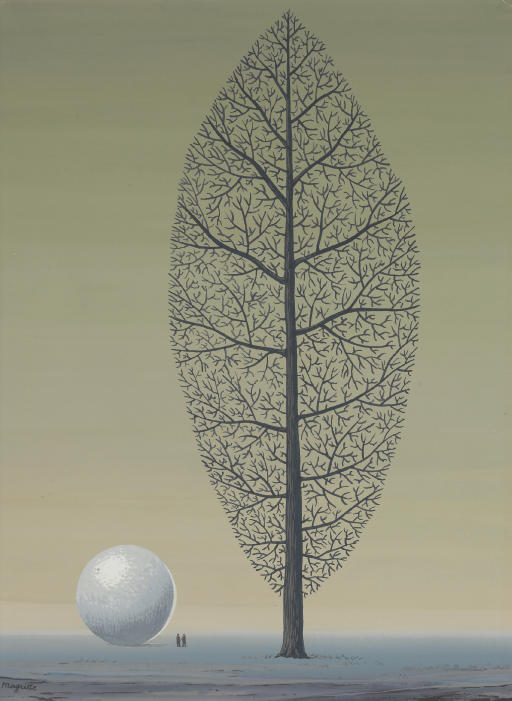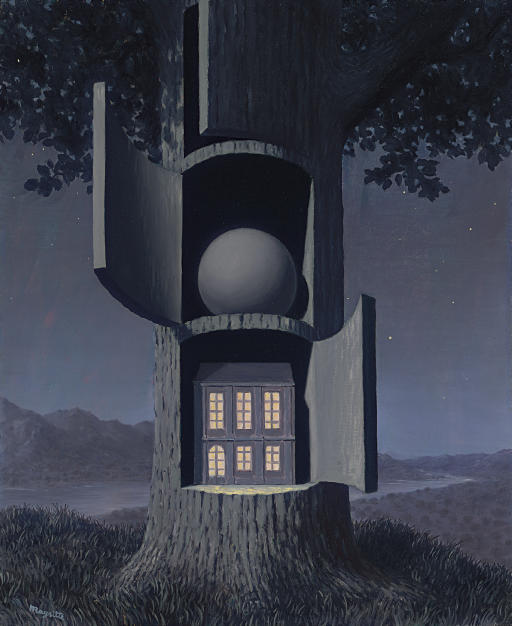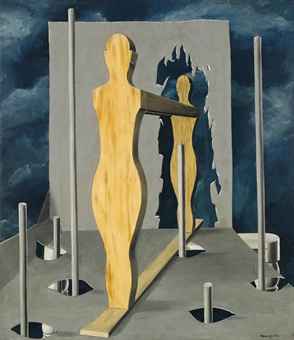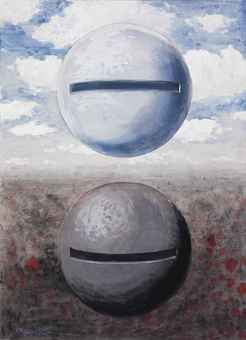Christie’s The Art of the Surreal Evening Sale on Tuesday 2 February 2016
Painted in 1942, Mesdemoiselles de l'Isle Adam by René Magritte (1898-1967) showcases the layers of wit, beauty, mystery and subversion that characterised the greatest of his pictures from the period (estimate: £2-3 million). It is telling that this picture has had such a distinguished history: after remaining in Magritte's hands for around a decade, it was acquired by his friend Justin Rakofsky, before entering the collection of Gustave Nellens, the owner of the casino at Knokke-le-Zoute, Belgium, which was decorated with monumental murals by Magritte. As with the greatest of Magritte's works, this painting plays with the viewer's preconceptions of art, and therefore of life. Mesdemoiselles de l'Isle Adam dates from a crucial watershed in Magritte's life when, in a bold response to the Second World War which had engulfed Magritte, his work moved toward a lighter and brighter approach.
Christie’s Impressionist & Modern Art Evening Sale in London on 23 June, 2015
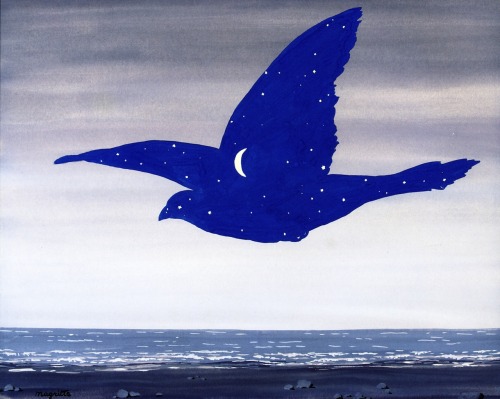
Offered from a European Private Collection, Le baiser, circa 1957, a gouache on paper by René Magritte (1898-1967), presents one of Magritte’s most poetic subjects: the oiseau de ciel, or ‘Sky-Bird’ (estimate: £1.2-1.8 million). This work presents the viewer with a rare and yet greatly celebrated motif that first entered his oeuvre in 1940 in
Le retour, now in the Musées Royaux des Beaux-Arts de Belgique.
The ‘Sky-Bird’ would come to gain international recognition in part through the later adoption by the Belgian national air carrier, Sabena, of a variant of this theme. In the case of the Sabena image, entitled
L'oiseau de ciel
and painted in 1966, the silhouette of a bird was shown filled with a cloudy, day-lit sky against a dark background, whereas in Le baiser, created roughly a decade earlier, Magritte has shown the silhouette as a pool of star-speck led night sky against the backdrop of day, with the sea and a beach underneath.
Le baiser, circa 1957, is one of four works by Magritte in the sale, which also includes
La grande marée, circa 1957 (estimate: £600,000 – 900,000)
and Le chant d'amour, circa 1962 (estimate: £300,000-500,000)
which are both offered from a distinguished private Belgian Collection, as well as
L'art de la conversation, 1955, (estimate: £300,000-500,000).
which is being sold from a private American Collection The market for works by Magritte is particularly strong with Christie’s selling all nine examples offered last February in London, which constituted the most extraordinary and extensive selection of works by the artist to come to the market since the landmark Harry Torczyner sale in 1998 at Christie’s New York.
Christie's Art of The Surreal on 4 February 2015
A total of 9 works by René Magritte are presented in the sale, 8 of which are from the Distinguished European Collection which
comprises 4 oils on canvas and 4 gouaches on paper. This season’s
offering by the artist spans Magritte’s oeuvre and includes much of his
most iconic imagery, together constituting the most extraordinary and
extensive group of works by Magritte to come to the market since the
landmark Harry Torczyner sale in 1998, which took place at Christie’s
New York and established new market price levels for the artist. Leading
the group is
Les compagnons de la peur, a triumphantly eerie work from 1942 which centres on the subject of transformation, challenging the realms of possibility and turning the traditions of landscape and portraiture painting on their head, to present – perched atop a mountain - four owls transforming from bird to plant world, or vice-versa (estimate: £2.7-3.5 million).
Magritte’s highly poetic gouache Le thérapeute, 1962, subverts the nature of pictures and the concept of the portrait with the captivating absence at the heart of the composition: the torso of the subject is a void through which the blue sky and clouds of a summer’s day entices the viewer beyond the twinkling night sky (estimate: £600,000-900,000, ).
The fragmentation of the human body and depiction of isolated body parts in René Magritte’s Les Belles Relations (ext. £2-3 million) is not only an important theme in the artist’s works, but also one that expresses the essence of Surrealism in general. It was this arresting work that was chosen as the icon of the now-famous Surrealist exhibition Two Private Eyes, held at The Solomon R. Guggenheim Museum in New York in 1999, featuring on the exhibition posters. The imagery of the present composition has its roots in Magritte’s celebrated bowler-hatted man, which has undergone several metamorphoses in which the man’s head has gradually disappeared, giving way to an impersonal assembly of its main parts. It is by combining the subject of a faceless modern man with the timeless and the unknowable, that Magritte questions our perception of reality and unveils the mystery hidden in everyday images.
Sotheby’s Surrealist Art Evening Sale 3rd February 2015
René Magritte
L’explication
oil on canvas 80 by 60cm, 31 1/2 by 23 5/8in. Painted in 1952 Estimate: £4 - 6 million
Important highlights of the forthcoming February sale include René Magritte’s L’explication, which comes to the market from a private collection for the first time in 35 years, Yves Tanguy’s extremely fine painting Deux fois du noir, and the finest group of Picabia's celebrated ‘Transparence’ paintings ever to come to the market.
Painted in 1952, Magritte’s L’explication is among his most compelling in engagements with the Surrealist interrogation and transformation of the object. The foreground of the composition is dominated by a striking amalgamation of bottle and carrot that sits on a solid wooden table surrounded by examples of its constituent parts, through which Magritte explores the idea that the combination of two related objects could create a poetic dynamic just as intense as the combination of two completely incongruous objects.
René Magritte
Les belles réalités
Gouache on paper 34.5 by 26cm.; 131⁄2 by 101⁄4in Executed in 1962 Est. £700,000-1,000,000
Executed in 1962, Les belles réalités will now be offered at auction for the very first time. A witty and compelling example of Magritte’s preoccupation with the unexpected juxtaposition of objects, the painting features the most iconic element to appear in his work - that of the apple. Both the apple and table are closely associated with the tradition of still life painting, which make them the ideal subjects for a Surrealist work. The present work is remarkable for its bright tones and intricate brushwork which reveals the brilliant talent of the painter and the importance of gouache in his oeuvre.
The fragmentation of the human body and depiction of isolated body parts in René Magritte’s Les Belles Relations (ext. £2-3 million) is not only an important theme in the artist’s works, but also one that expresses the essence of Surrealism in general. It was this arresting work that was chosen as the icon of the now-famous Surrealist exhibition Two Private Eyes, held at The Solomon R. Guggenheim Museum in New York in 1999, featuring on the exhibition posters. The imagery of the present composition has its roots in Magritte’s celebrated bowler-hatted man, which has undergone several metamorphoses in which the man’s head has gradually disappeared, giving way to an impersonal assembly of its main parts. It is by combining the subject of a faceless modern man with the timeless and the unknowable, that Magritte questions our perception of reality and unveils the mystery hidden in everyday images.
Christie’s: The Art of The Surreal 6 February 2013
- A remarkable group of nine works by Renè Magritte(1898-1967) is led by
Le plagiat (Plagiary), 1940, which unites nature, beauty and mystery (estimate: £2-3 million, ). Never before offered at auction, it has been in a private Belgian collection since it was painted. This is an incredibly rare work as while many of Magritte’s motifs were revisited in a string of pictures, he created only one other oil painting titled Le plagiat, in 1942 in a vertical format.
This work shows the elective affinities which underpinned the greatest of his paintings: a bunch of cut flowers has been shown in a vase, yet instead of the flowers themselves, the viewer sees a related subject, a blooming landscape in a cut-out silhouette. Next to the white vase is a nest with three eggs, an enigmatic presence in the interior view which again allows the outdoors to invade an indoor space.
First exhibited in a Salon in Liège in 1940, the year it was painted, Le plagiat was acquired from the exhibition by Ernest van Zuylen, a member of a wealthy merchant family who was both a keen supporter of the arts and a prolific photographer. Magritte painted this original, first version of Le plagiat in January 1940, shortly before the invasion of Belgium but after the beginning of the Second World War. This was a moment of incredible international tension, not least for an artist associated with a subversive view of the world and with political statements that one could imagine would not sit well with any occupying forces.
While some artists, especially among the Surrealists, sought to channel, express or address this tension, Magritte instead sought to create a slender ray of light, a beacon of hope. A meditation on beauty, Le plagiat shows a room filled with a bunch of flowers which itself becomes a form of window or portal opening up to a lyrically idyllic landscape. Magritte continued to channel positive feelings in his work throughout the Occupation, following the invasion which occurred only months after Le plagiat was painted.
A miraculous apparition dominates Tous les jours (Everyday), painted by Renè Magritte (1898-1967) in 1966 (estimate: £1.8-2.5 million, illustrated below). Having joined an important private collection only a year after it was executed, it has remained in the same collection – from which it is now offered - for over 40 years. Against the backdrop of a dramatic, largely barren, landscape are the eyes, nose and mouth of a man, hovering in the air and bracing the viewer with an uncanny gaze.
Tous les jours was one of a group of pictures that Magritte created during this period, exploring the concept of emptiness and combining it in several cases with the tradition of portraiture which he had gleefully disrupted and undermined throughout his career. The face of the subject appears almost discernible, despite being fragmentary, in part due to the striking scale of the nose. In this sense, Magritte has conveyed an impressive but certainly ambiguous sense of realism through this deliberately absurd composition.
Such isolation of facial features first appeared in Magritte’s work only shortly before this picture was painted in Le paysa ge de Baucis, which had emerged as his solution to one of his visual quandaries: how to represent the space between a woman’s hat and her dress. In 1966 he found the solution in male form noting: ‘I have discovered how to paint the emptiness between a hat and a man’s suit without suggesting “The Invisible Man” ‘by including floating facial features - the eyes, nose and mouth - which articulate and dramatically highlight the ‘emptiness.’ In Tous les jours, emptiness is pushed to a new extreme as the face is shown against a vast background, rather than hanging within the context of a human head and body. The contrast between the flesh and the rock-strewn scrub and mountains of the landscape adds a textural dimension to the tension between these disparate elements thrusting them into bolder relief. A face appearing in such fragmentary form appears to relate to Magritte’s earlier series, in which the eyes and mouth of a woman appeared in the midst of strings of pearls.
A further important work by Magritte Ceci n'est pas une pomme (This is not an apple), 1964, (estimate: £1-1.5 million) leads a group of four works in The Art of the Surreal Evening Sale which are offered from the former collection of the Scheringa Museum of Realist Art, Holland.
Sotheby’s Evening sale of Impressionist and Modern Art, 8th February 2011
Of note in the sale on the 8th February are four gouaches and an oil painting by René Magritte.
René Magritte (1898 - 1967), La Joconde. Est: £1.8-2.5 million.
The oil, La Joconde (est: £1.8-2.5 million) is a remarkable example of Magritte's mature painting, uniting some of the best known elements of the artist's iconography: the curtain, the bell and the sky, all depicted against a neutral background. The composition is dominated by the monumental curtains, through which Magritte presents a juxtaposition of opposites – the paradox of concealing and revealing, and the contrast between the natural and the man-made, between interior and exterior settings. By confronting these contrasted elements, Magritte evokes the essential surrealist paradigm of questioning the significance and purpose we attribute to various objects, and creating new meanings by placing these objects in new and unexpected contexts.
Two of the Magritte gouaches in the sale depict the artist’s single most iconic motif, the bowler-hatted man:
René Magritte (1898 - 1967), Le Maître d’École, 1955. Est. £800,000 - 1,200,000. Photo: Sotheby's
René Magritte (1898 - 1967), Les Tambours de la Mort, circa 1965. Est. £800,000 - 1,200,000. Photo: Sotheby's
Joan Miró is represented in the sale with a striking example of the artist’s late works, Femme, 1978 (est: £900,000-£1.2 million), which features the characteristic iconography that occupied the artist throughout his career. For Miró, women, birds, stars, the moon, the sun, night and dusk formed a poetic language, and the present work shows his style verging between figuration and abstraction. While taking a recognisable image as his starting point, the artist builds his composition using a pictorial lexicon of signs and symbols.
Sotheby's 2013
Les compagnons de la peur, a triumphantly eerie work from 1942 which centres on the subject of transformation, challenging the realms of possibility and turning the traditions of landscape and portraiture painting on their head, to present – perched atop a mountain - four owls transforming from bird to plant world, or vice-versa (estimate: £2.7-3.5 million).
Magritte’s highly poetic gouache Le thérapeute, 1962, subverts the nature of pictures and the concept of the portrait with the captivating absence at the heart of the composition: the torso of the subject is a void through which the blue sky and clouds of a summer’s day entices the viewer beyond the twinkling night sky (estimate: £600,000-900,000, ).
The fragmentation of the human body and depiction of isolated body parts in René Magritte’s Les Belles Relations (ext. £2-3 million) is not only an important theme in the artist’s works, but also one that expresses the essence of Surrealism in general. It was this arresting work that was chosen as the icon of the now-famous Surrealist exhibition Two Private Eyes, held at The Solomon R. Guggenheim Museum in New York in 1999, featuring on the exhibition posters. The imagery of the present composition has its roots in Magritte’s celebrated bowler-hatted man, which has undergone several metamorphoses in which the man’s head has gradually disappeared, giving way to an impersonal assembly of its main parts. It is by combining the subject of a faceless modern man with the timeless and the unknowable, that Magritte questions our perception of reality and unveils the mystery hidden in everyday images.
Sotheby’s Surrealist Art Evening Sale 3rd February 2015
René Magritte
L’explication
oil on canvas 80 by 60cm, 31 1/2 by 23 5/8in. Painted in 1952 Estimate: £4 - 6 million
Important highlights of the forthcoming February sale include René Magritte’s L’explication, which comes to the market from a private collection for the first time in 35 years, Yves Tanguy’s extremely fine painting Deux fois du noir, and the finest group of Picabia's celebrated ‘Transparence’ paintings ever to come to the market.
Painted in 1952, Magritte’s L’explication is among his most compelling in engagements with the Surrealist interrogation and transformation of the object. The foreground of the composition is dominated by a striking amalgamation of bottle and carrot that sits on a solid wooden table surrounded by examples of its constituent parts, through which Magritte explores the idea that the combination of two related objects could create a poetic dynamic just as intense as the combination of two completely incongruous objects.
René Magritte
Les belles réalités
Gouache on paper 34.5 by 26cm.; 131⁄2 by 101⁄4in Executed in 1962 Est. £700,000-1,000,000
Executed in 1962, Les belles réalités will now be offered at auction for the very first time. A witty and compelling example of Magritte’s preoccupation with the unexpected juxtaposition of objects, the painting features the most iconic element to appear in his work - that of the apple. Both the apple and table are closely associated with the tradition of still life painting, which make them the ideal subjects for a Surrealist work. The present work is remarkable for its bright tones and intricate brushwork which reveals the brilliant talent of the painter and the importance of gouache in his oeuvre.
In
keeping with growing demand for Surrealist works, particularly by René
Magritte, Christie’s is pleased to present three important works by the
Belgian master, each representing a distinct period and theme in the
artist’s career.
- Mesdemoiselles de l’Isle Adam belonged to Gustave Nellens, owner of the seaside Casino Communal at Knokke-Le-Zoute in Belgium, who commissioned Magritte in 1953 to design the panoramic mural Le domaine enchanté.
- Monumental in size, Mesdemoiselles de l’Isle Adam, encompasses two of the artist’s signature elements, the nude female, and a blue sky, which Magritte fashions as both the background and the foreground with his dexterous use of cut-outs.
- Magritte painted L’ombre céleste in 1927, in the first of three years that he spent in Paris. Magritte’s time in Paris has been described as the most creative period in his career.
- This work was included in MoMA’s controversial and groundbreaking exhibition, Fantastic Art, Dada, Surrealismfrom December 1936-January 1937.
- L’ombre celeste was acquired by Beth Straus in the early 1960’s from the New Art Center in New York, with whom it remained until 1976, when the present owner received it by descent.
- The artist explained the title, La vie privée, saying “Every person has a private life which, on further acquaintance, can be perceived as through a window”.
Sotheby’s Surrealist Art Sale: 5th February 2013
The fragmentation of the human body and depiction of isolated body parts in René Magritte’s Les Belles Relations (ext. £2-3 million) is not only an important theme in the artist’s works, but also one that expresses the essence of Surrealism in general. It was this arresting work that was chosen as the icon of the now-famous Surrealist exhibition Two Private Eyes, held at The Solomon R. Guggenheim Museum in New York in 1999, featuring on the exhibition posters. The imagery of the present composition has its roots in Magritte’s celebrated bowler-hatted man, which has undergone several metamorphoses in which the man’s head has gradually disappeared, giving way to an impersonal assembly of its main parts. It is by combining the subject of a faceless modern man with the timeless and the unknowable, that Magritte questions our perception of reality and unveils the mystery hidden in everyday images.
Christie’s: The Art of The Surreal 6 February 2013
- A remarkable group of nine works by Renè Magritte(1898-1967) is led by
Le plagiat (Plagiary), 1940, which unites nature, beauty and mystery (estimate: £2-3 million, ). Never before offered at auction, it has been in a private Belgian collection since it was painted. This is an incredibly rare work as while many of Magritte’s motifs were revisited in a string of pictures, he created only one other oil painting titled Le plagiat, in 1942 in a vertical format.
This work shows the elective affinities which underpinned the greatest of his paintings: a bunch of cut flowers has been shown in a vase, yet instead of the flowers themselves, the viewer sees a related subject, a blooming landscape in a cut-out silhouette. Next to the white vase is a nest with three eggs, an enigmatic presence in the interior view which again allows the outdoors to invade an indoor space.
First exhibited in a Salon in Liège in 1940, the year it was painted, Le plagiat was acquired from the exhibition by Ernest van Zuylen, a member of a wealthy merchant family who was both a keen supporter of the arts and a prolific photographer. Magritte painted this original, first version of Le plagiat in January 1940, shortly before the invasion of Belgium but after the beginning of the Second World War. This was a moment of incredible international tension, not least for an artist associated with a subversive view of the world and with political statements that one could imagine would not sit well with any occupying forces.
While some artists, especially among the Surrealists, sought to channel, express or address this tension, Magritte instead sought to create a slender ray of light, a beacon of hope. A meditation on beauty, Le plagiat shows a room filled with a bunch of flowers which itself becomes a form of window or portal opening up to a lyrically idyllic landscape. Magritte continued to channel positive feelings in his work throughout the Occupation, following the invasion which occurred only months after Le plagiat was painted.
A miraculous apparition dominates Tous les jours (Everyday), painted by Renè Magritte (1898-1967) in 1966 (estimate: £1.8-2.5 million, illustrated below). Having joined an important private collection only a year after it was executed, it has remained in the same collection – from which it is now offered - for over 40 years. Against the backdrop of a dramatic, largely barren, landscape are the eyes, nose and mouth of a man, hovering in the air and bracing the viewer with an uncanny gaze.
Tous les jours was one of a group of pictures that Magritte created during this period, exploring the concept of emptiness and combining it in several cases with the tradition of portraiture which he had gleefully disrupted and undermined throughout his career. The face of the subject appears almost discernible, despite being fragmentary, in part due to the striking scale of the nose. In this sense, Magritte has conveyed an impressive but certainly ambiguous sense of realism through this deliberately absurd composition.
Such isolation of facial features first appeared in Magritte’s work only shortly before this picture was painted in Le paysa ge de Baucis, which had emerged as his solution to one of his visual quandaries: how to represent the space between a woman’s hat and her dress. In 1966 he found the solution in male form noting: ‘I have discovered how to paint the emptiness between a hat and a man’s suit without suggesting “The Invisible Man” ‘by including floating facial features - the eyes, nose and mouth - which articulate and dramatically highlight the ‘emptiness.’ In Tous les jours, emptiness is pushed to a new extreme as the face is shown against a vast background, rather than hanging within the context of a human head and body. The contrast between the flesh and the rock-strewn scrub and mountains of the landscape adds a textural dimension to the tension between these disparate elements thrusting them into bolder relief. A face appearing in such fragmentary form appears to relate to Magritte’s earlier series, in which the eyes and mouth of a woman appeared in the midst of strings of pearls.
A further important work by Magritte Ceci n'est pas une pomme (This is not an apple), 1964, (estimate: £1-1.5 million) leads a group of four works in The Art of the Surreal Evening Sale which are offered from the former collection of the Scheringa Museum of Realist Art, Holland.
Sotheby’s Evening Sale of Impressionist and
Modern Art on 2 May 2012
The sale included a fantastic group of five gouaches by René Magritte from a private
European collector that have been in the same collection since 1967. They encompass some of the artist’s best-
known themes and together are estimated to sell for $2.7/3.8 million.
Chief among them is Le Viol, a very rare and famous image in the artist’s oeuvre ( est. $700,000/1 million).
Also included is La Voix du sang, which typifies the elaborate treachery of the artist’s images ( est. $600/800,000).
Chief among them is Le Viol, a very rare and famous image in the artist’s oeuvre ( est. $700,000/1 million).
Also included is La Voix du sang, which typifies the elaborate treachery of the artist’s images ( est. $600/800,000).
Marine, 1948
Est. $500/700,000
Est. $500/700,000
Sotheby’s Evening sale of Impressionist and Modern Art, 8th February 2011
Of note in the sale on the 8th February are four gouaches and an oil painting by René Magritte.
René Magritte (1898 - 1967), La Joconde. Est: £1.8-2.5 million.
The oil, La Joconde (est: £1.8-2.5 million) is a remarkable example of Magritte's mature painting, uniting some of the best known elements of the artist's iconography: the curtain, the bell and the sky, all depicted against a neutral background. The composition is dominated by the monumental curtains, through which Magritte presents a juxtaposition of opposites – the paradox of concealing and revealing, and the contrast between the natural and the man-made, between interior and exterior settings. By confronting these contrasted elements, Magritte evokes the essential surrealist paradigm of questioning the significance and purpose we attribute to various objects, and creating new meanings by placing these objects in new and unexpected contexts.
Two of the Magritte gouaches in the sale depict the artist’s single most iconic motif, the bowler-hatted man:
René Magritte (1898 - 1967), Le Maître d’École, 1955. Est. £800,000 - 1,200,000. Photo: Sotheby's
René Magritte (1898 - 1967), Les Tambours de la Mort, circa 1965. Est. £800,000 - 1,200,000. Photo: Sotheby's
Joan Miró is represented in the sale with a striking example of the artist’s late works, Femme, 1978 (est: £900,000-£1.2 million), which features the characteristic iconography that occupied the artist throughout his career. For Miró, women, birds, stars, the moon, the sun, night and dusk formed a poetic language, and the present work shows his style verging between figuration and abstraction. While taking a recognisable image as his starting point, the artist builds his composition using a pictorial lexicon of signs and symbols.
Sotheby's 2013
René Magritte
LES BELLES RELATIONS
LOT SOLD.
1,945,250 GBP
Christie's 2007
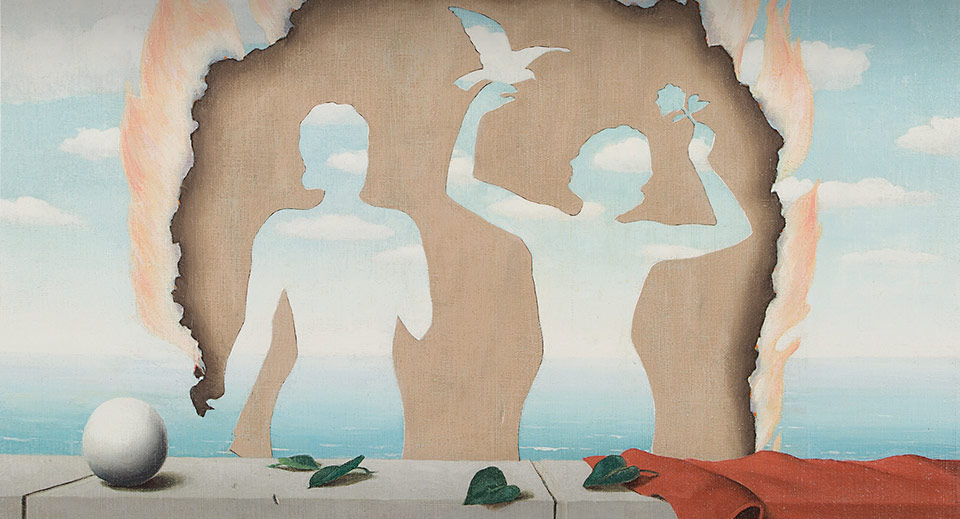


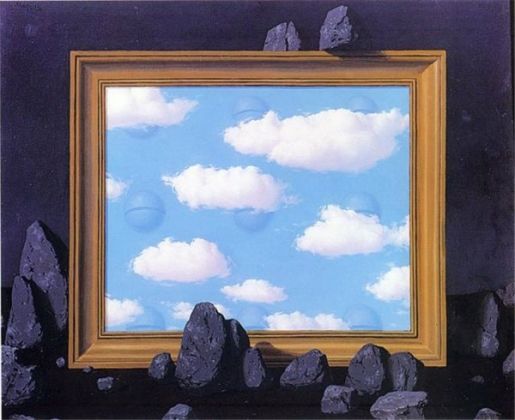



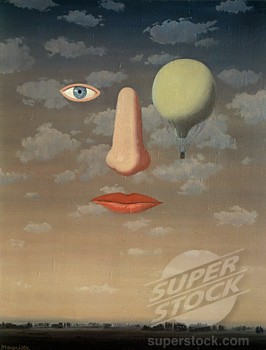



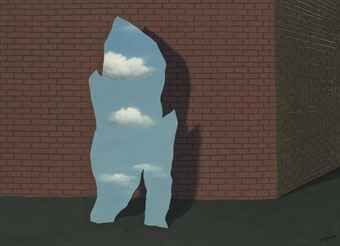
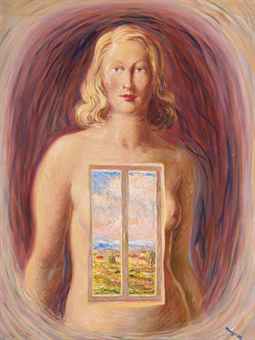
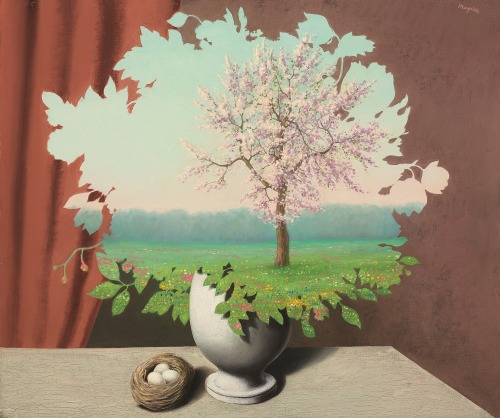

.jpg)


